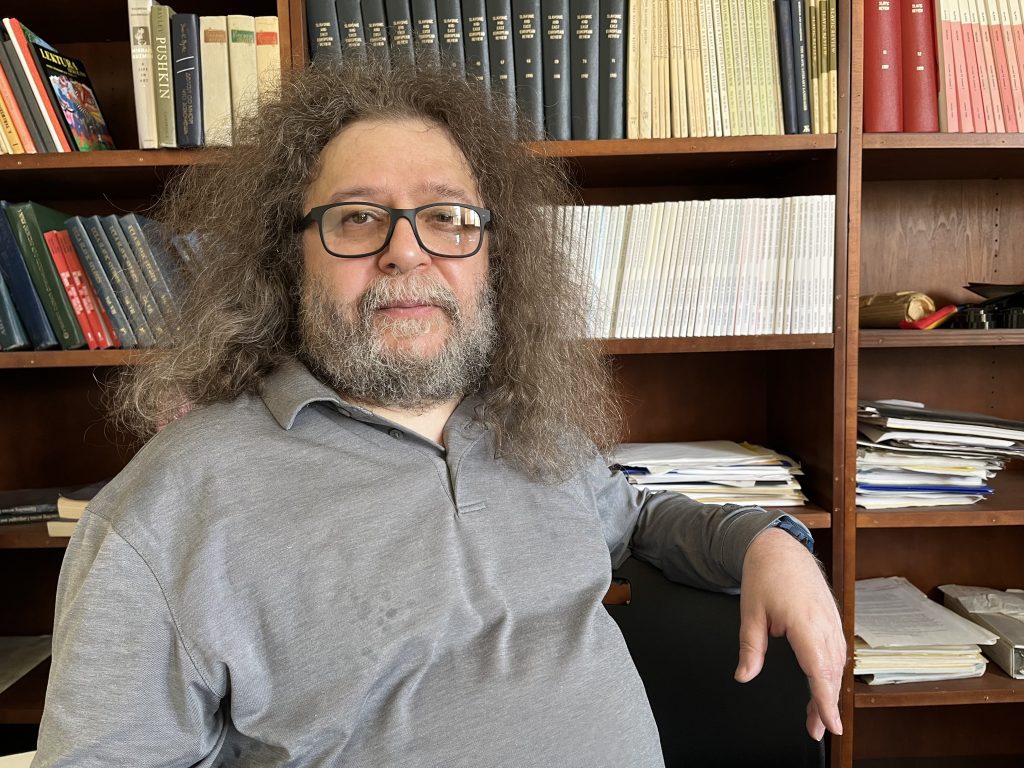Not just word-for-word: Igor Pilshchikov on the nuances and challenges of translation

Marta Wallien/UCLA
Igor Pilshchikov has had his writing published in a total of 11 languages.
| June 10, 2024
When most people read works that have been translated from another language, they tend to take for granted the painstaking work that went into the translation.
Translation is as much art as it is science — and it involves so much more than just finding literal replacements for each individual word in the new language. Translators must take into account cultural meaning; a common turn of phrase in American English might be nonsensical without context to readers in Russia, and vice versa.
UCLA professor Igor Pilshchikov is more than familiar with those challenges. The chair of the Department of Slavic, East European & Eurasian Languages & Cultures, Pilshchikov has had his writing published in a total of 11 languages and often collaborates with other translators to reproduce his work.
In an interview, Pilshchikov spoke about the challenges of “language-embedded concepts,” why two translators are usually better than one, and why AI models aren’t very helpful so far.
You often translate your articles into other languages. What initially drove you to publish translations?
After I graduated from university in the early 1990s, I went to teach in the United Kingdom and, quite naturally, started publishing in English. When I returned to Russia, I continued to publish in English and added Russian.
But I soon realized that people in many countries — for example France or Italy — don’t read in English much, or at least prefer reading scholarly texts in their native languages. So I decided to expand the linguistic diversity of my publications. Besides English and Russian, I have already published in nine other languages, including Spanish and Portuguese to reach out to the Latin American academic audiences. My publications have also been published in Chinese, Czech, German, Estonian, Italian, French and Polish.
Do you translate your own work?
Unfortunately, I am not a full-fledged polyglot. I can write in some of these languages, but usually don’t dare to translate myself.
Instead, I ask my colleagues to translate and then authorize the translation. In all the languages I have published in — except Chinese, which I don’t know at all — I’m able to check their work and can change or add things.
The same happens when translations are initiated by translators themselves. Sometimes, I do it the other way around: I produce a literal translation into their language. They rework it, and then I rework it on my side.
My experience tells me that this is one of the best ways to translate: having two translators, with two different native tongues and very good knowledge of the other language.
What are the challenges in producing translations?
It’s impossible to translate literally and leave everything intact. First and foremost, different concepts can be commonly known in one culture and relatively unknown in another. For example, any scholar of Russian poetry knows what iamb or trochee are, but French or Spanish scholars usually don’t, unless they are familiar with classical Greek and Roman versification.
The reason is that French and Spanish syllabic verse is based on a different principle — a particular number of syllables in a verse line, rather than their contrasting differences. However, even the knowledge of classical versification does not always help because classical iambs and trochees are based on quantitative differences (long versus short syllables), whereas Russian, German or English iambs and trochees are based on qualitative differences (stressed versus unstressed syllables).
What are other common hurdles?
It’s not only cultural considerations — there also are language-embedded concepts that are different in different languages.
There are things that you must say in one language but can avoid saying in another language. A well-known example: In English, you can say, “I go there” and don’t need to specify if you’re walking, driving or riding. Contrarily, in Russian there is a verb meaning, “to drive or ride” (ekhat’), and a verb that means “to walk” (idti), but no verb with a general meaning “to go.” In Russian, it’s unavoidable: You have to specify. The opposite is also true. The difference between driving and riding is not expressed in Russian, unless you mention what you are driving or riding.
Another example: In Russian, the common verb risovat’ means both “to paint with a brush” and “to draw with a pencil.” You wouldn’t be able to guess if a verbally described image is drawn or painted, unless the tool or technique are explicitly mentioned. If it’s your text, you most likely know what you meant. If it’s somebody else’s text, you need to reconstruct what the author wanted to say, and this is not so easy.
Such differences are not rare exceptions — they are multiple and all-pervading.
Other challenges are related to style. The styles of academic writing are very different in different linguistic traditions. If you literally translate an English scholarly article into Russian, or vice versa, the resulting text will be awkward and many passages would simply sound ridiculous. And machine translation and AI can’t help with that — at least not yet.
